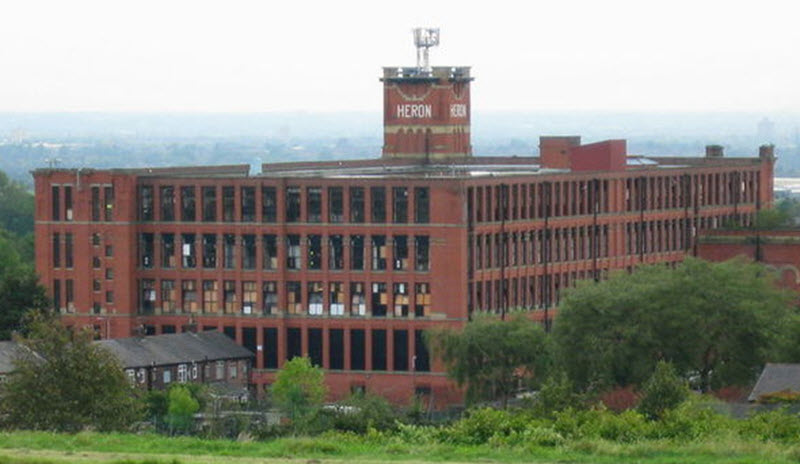Contents
Ace Mill is a cotton spinning mill in Chadderton, built in 1914 and used to spin cotton from 1919. Chadderton is located within the Greater Manchester area.
The mill’s original name was Gorse No. 2 Mill, but it was renamed Ace Mill by Ace Mill Ltd in 1919.
In the 1930s, the mill was taken over by the Lancashire Cotton Corporation. The current owners, Courtaulds, has owned the mill since 1964. The mill has not been used for spinning since 1967. It is currently used as a warehouse.
The Ace Mill is very centrally located. It is situated within 100m from a CostCo and less than 200m from a McDonalds. Other things close to the Ace Mill include Subway and a number of other restaurants.
If you want to get a bite to eat near Ace Mill then we recommend Indish. A good Indian restaurant located about 300 m from the mill.

Short facts
| Owner | 1.) Ace Mill Ltd
2.) Lancashire Cotton Corporation (1930s) 3.) Courtaulds (1964-) |
| Built | 1914 |
| Location | Chadderton, Greater Manchester, England |
| Coordinates | 53.5312°N 2.1565°W |
| Serving canal | Rochadel Canal
Hollinwood Branch Canal |
| Serving railway | Oldham Loop Line |
Where is it?
Ace Mill is located in the Metropolitan Borough of Oldham within the Greater Manchester area in England. You will find it in the Whitegate area of south Chadderton, on elevated ground between the rivers Irk and Medlock.
This mill has commonly been referred to as “Ace Mill, Hollinwood”, even though it isn’t located in Hollinwood. The reason for this is that the closest serving railwaystation is the Hollinwood station. Oldham is surrounded by several smaller settlements which together form the Metropolitan Borough of Oldham. Hollinwood and Chadderton are both examples of such smaller settlements.
The building and the equippment
The Ace Mill, designed by P.S. Stott, is a five-storey building with a floora area of 38,500 square feet.
When the mill commenced operation in 1919, it contained 118,032 spindles from the Platts manufacturer. The cotton count was 1’s to 20’s.
In 1920, Urmson and Thompson built an engine for the Ace Mill; a 2500 hp cross compound engine (Mary and Elizabeth) with a 26 ft flywheel fitted with 42 ropes for transmission.
Background
The Ace Mill was by far the only mill in the Oldham region. In the 19th century, Oldham and its neighbooring settlements grew into an bustling centre for textile production and became one of the first industrialized towns in England. At one point, it was one of the most important centres for cotton textile production in all of Europe. Most of the cotton spun here was of courser counts.
The first spinning mill in Oldham – Lees Hall – was constructed by William Clegg in the late 1770s. At this point, Oldham was already a notable textile hub, but the raw material was not cotton – it was wool. The soils around Oldham wasn’t good for growing crops, but could support grazing sheep. A lot of wool was produced and this sustained a local woollen weaving trade. The wool wasn’t processed in big factories however, but in the homes of various cottagers. The shift from wool to cotton would change this, as huge cotton mills were created where workers would toil away from their homes and families.
Within a year after the erection of Lees Hall, another eleven (!) spinning mills had sprung up in the Oldham. By 1818, the number of privately owned spinning mills in Oldham was 19.
At the midpoint of the 19th century, over 30% of Oldham’s population was employed within the textile sector. (In Great Britain as a whole, only 5% of the population worked in the textile industry.)
The Ace Mill
The start
By 1911, 16.4 million of the United Kingdom’s 58 million spindles were found in Oldham. The total number of spindles in the world at this point were slightly below 144 million. This is the booming environment in which Gorse No.2 Mill is contructed in 1914.
The Gorse No. 2 Mill was planned in 1911, and the builder P.S. Stott finnished building it in 1914.
The war
1914 wasn’t just the year when the building of Gorse No. 2 Mill was finnished; it was also the year when World War I broke out. During the war (1914-1918), the building was used for aircraft manufacturing. Because of this, cotton spinning didn’t commence until 1919.
After the war
The war came to cast a shaddow over the Oldham cotton industry even after it had ended. During the war, importing raw cotton to the British Isles became virtually impossible. Because of this, the British government promoted the erection of spinning mills and weaving factories in British colonies where cotton was grown and didn’t need to be imported. After the war, those mills were still there, compteting with the mills on the British Isles.
In 1929, the Bank of England created the Lancashire Cotton Corporation in an attempt to save struggling cotton factories by buying them and rationalising them. Over one hundred mills were purchased by the corporation, and one of them was Ace Mill in Oldham.